The Crab Nebula in Narrowband

French astronomer Charles Messier was searching for the return of Halley’s comet in 1758 when he spotted an 8th-magnitude misty patch in Taurus. When he realized that the object was not a comet, it became the first entry in his famous list of objects-not-to-be-confused-with comets. It was named the Crab Nebula by Lord Rosse in 1844 who sketched the object while observing it with his 36-inch telescope at Birr Castle in Ireland.
But Messier was not the first to see it. It had been spotted some 17 years earlier by John Bevis, but more significantly it had originally been observed by Chinese astronomers in 1054AD as a ‘new star’ (or supernova) that shone so brightly it was visible in daylight, and remained a naked-eye object for two years. When astrophotography came on the scene in the early 20th century, it was discovered from photographs taken a few years apart that the nebula was expanding. Extrapolating back in time revealed an origin about 900 years earlier, thus identifying it with the 1054 supernova.
The Crdsab nebula is one of the most interesting objects in the sky. Apart from being the first supernova remnant to be identified, it was discovered in 1968 that there is a pulsar at the centre of the nebula: that is, a neutron star** rotating 30 times per second and beaming energy from its magnetic poles that is powering the glow of the nebula.
The Crab is about 6,500 light years away, which gives some idea of the energy of a supernova explosion if it remained a naked-eye object for two years. It also means that the actual explosion occurred in about 5,500 BC, but of course there is no way we could see it until the light arrived here in 1054 AD.
This is a narrowband image taken through 3 filters: H-α (at a wavelength of 626 nm), O-III (at 496 nm) and S-II (at 672 nm). Total imaging time was: H-α 26 hrs, OIII 30 hrs and SII 38 hrs, with observations being spread over three imaging runs in 2020, 2022 and 2023.
Since our eyes perceive colour in the three broadband RGB ‘channels’ it is necessary to map the narrowband to these channels in some way, hence creating what is often called a ‘false colour’ image. How the channels are mixed is a personal choice but following the lead of the Hubble team, in this case the SII signal is mapped to the red channel, the H-α to the green and the O-III to the blue. As it happens, both the SII and the H-α spectral lines lie in the red region of the visible spectrum while the OIII is in the green. However we cannot map both H-α and SII to the red or we would not be able to distinguish them from each other. This is why many narrowband images have a pronounced green colour, as the H-α is the strongest signal.
The pulsar is visible in the image and its position is indicated below.
Equipment: Planewave CDK-14, FLI Proline P9000 CCD camera, Astrodon 3-nm filters, ACP/MaximDL/PWI control software. Processed in PixInsight.
** As an aside, neutron stars are the leftover cinders of massive stars that have undergone a core-collapse supernova. They are highly exotic objects whose density approaches that of neutrons themselves, some 1017 kg m-3. The usual way this is related to our everyday experience is that a teaspoonful of nuclear matter would weigh about half a billion tons. The reason some neutron stars spin so fast is due to the conservation of angular momentum. A star like the sun that rotates about once a month will start to rotate faster as it collapses, like a skater spinning faster on the spot as she pulls her arms in. By the time the core of the star has collapsed to the size of a city (shrinking by a factor of perhaps 5,000) it is spinning very fast indeed – in the case of the Crab pulsar, 30 times per second.
The first pulsar was discovered in 1967 by Jocelyn Bell, a graduate student, using the Interplanetary Scintillation Array at the Mullard Radio Astronomy centre in Cambridge. Despite making the discovery herself, and having to argue its authenticity against the opinion of Anthony Hewish, her PhD supervisor, she received no official credit when Hewish was awarded the 1974 Nobel prize. Bell (later Bell Burnell) was philosophical about the decision, commenting that it would have been very unusual for a student to be awarded a Nobel prize. She went on to have a very successful career and has received numerous awards and honours.
There are many other interesting aspects to the Crab nebula, so much so that one astronomer in the 1970s was quoted as saying ‘There are two kinds of astronomy: the astronomy of the Crab nebula, and the astronomy of everything else!’



0 Comments